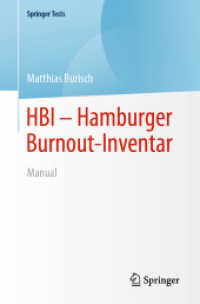- ホーム
- > 洋書
- > 英文書
- > Business / Economics
基本説明
Provides interviews with companies that have improved their budgeting and financial reporting processes.
Full Description
"The budget and financial reporting processes are well known sources of frustration for most CFOs. Seeking a quick fix to the problem, the common solution is to pour more money into new and better software. This leaves the root cause, the inefficient and dysfunctional underlying processes and routines, unaddressed. As this book shows, substantial and sustainable improvements are only achieved through an holistic approach to process improvement, technology, strategy, and people."
—Tom Henry Knudsen, Executive Vice President, Telenor Eiendom Fornebu AS, Proven methods for improving efficiency Corporations face a high turnover among financial managers, rapid changes in technology, lack of time and process redesign skills, and ongoing ambiguity about primary objectives behind the budgeting and financial reporting processes. Amid this frenzy, it is the fundamental efficiency of these processes that dramatically impact overall business performance. Process Improvement for Effective Budgeting and Financial Reporting provides financial managers with a compelling blueprint for increasing efficiency and eliminating waste of time and energy. Four operational experts lay out an 80/20 plan-improving 80% of processes in 20% of the time it would take to improve 100%-and explain a Business Process Improvement (BPI) plan that incorporates:
The emerging trends affecting financial managers today
Step-by-step process implementation
Interviews with industry leaders, consultants, and managers who have successfully instituted BPI plans
Appraisals of the available software that can help or hinder the process
There is no substitute for improved efficiency. CFOs, controllers, budget managers, and financial analysts will significantly benefit from adding this authoritative guide to their professional libraries.
Contents
Preface. Part One: Introduction to Business Process Improvement.
1. About Business Process Improvement.
Introduction.
Why Focus on Budgeting and Reporting Processes?
Positive Effects of BPI.
Implementing Change.
Phases of a BPI Project.
Core Budgeting and Reporting Processes.
Closing Remarks.
2. When BPI Is Valuable.
Preconditions for BPI.
What BPI Can Do for a Company.
BPI Overview.
3. Small and Large Projects and Associated Resources.
4. Return on Investment of BPI Projects.
5. Best Practices, Trends, and Technology.
Technology Trends.
Analytics and Balanced Scorecard.
Impact of the Internet.
6. Selling Change to Your Organization.
How to Sell a BPI Project.
Part Two: Business Process Improvement Project.
7. Getting Started.
Budgeting and Reporting Overview: So You Want Perfect Analytics Processes?
Preparing for the BPI Project.
Summary of Current Issues: Simplified Example.
Using Diagrams to Visualize Processes.
8. Due Diligence.
Company Values.
Risks.
Strengths and Weaknesses.
9. Improving the Budgeting Process.
Establish a Timeline.
Improve Data Entry.
Do Forecasting.
Report on Budgets.
Complete Analysis.
Enforce Accountability.
Support Enablers.
10. Revenue Budgeting.
Objectives.
Customer Needs.
Dimensions and Chart of Account Considerations.
Drivers.
Top-Down or Bottom-Up Budgeting Approach.
Assumptions.
Special Considerations.
Users.
Best Practices.
11. Employee Budgeting.
Objectives.
Customer Needs.
Dimensions and Chart of Account Considerations.
Top-Down or Bottom-Up Approach.
Drivers.
Assumptions.
Special Considerations.
Users.
Best Practices.
12. Cost of Sales and Operating Expenses.
Objectives.
Customer Needs.
Dimensions and Chart of Account Considerations.
Top-Down or Bottom-Up Approach.
Drivers.
Assumptions.
Special Considerations.
Users.
Best Practices.
13. Capital Expenses.
Objectives.
Customer Needs.
Dimensions and Chart of Account Considerations.
Top-Down or Bottom-Up Approach.
Drivers.
Assumptions.
Special Considerations.
Users.
Best Practices.
14. Balance Sheet and Cash Flow Statements.
Objectives.
Customer Needs.
Dimensions and Chart of Account Considerations.
Top-Down or Bottom-Up Approach.
Drivers.
Assumptions.
Special Considerations.
Users.
Best Practices.
15. Alternative Budgeting Approaches.
Zero-Based Budgeting.
Activity-Based Budgeting.
Balanced Scorecard.
Beyond Budgeting Round Table.
16. Improving Financial Reporting Processes.
Ethical Concerns.
Financial Reporting as a Business Process.
What's Wrong with This Picture?
Looking for Improvement Opportunities.
Evaluating Reporting Process Enablers.
17. Human Resources, Training, Strategy, and Workflow.
Human Resources.
Training.
Strategy.
Workflow.
18. Best Practices.
Closing.
Reporting.
19. Technology.
Analytics Applications and the Financial Data Warehouse.
Extract, Transform, and Load: Combining Data from Diverse Systems.
Using XBRL for External Reporting.
Intranets, Extranets, and Browsers: Using the Web to Distribute Operating and Financial Data.
20. BPI Makeover.
Summary.
Part Three: Designing the Ultimate Chart of Accounts.
21. Chart of Accounts Redesign.
Purpose.
When to Redesign.
22. Creating a New COA.
General Design Considerations.
Segment and Value Considerations.
Design Factors.
Other Considerations.
Features of a Basic Chart of Accounts.
Ideal Number and Use of Segments.
Ideal Length of Segments.
23. COA Development Plan.
Development Process.
International Considerations.
Sample COA Project Plan.
Recommendations and Other Considerations.
Summary.
Part Four: Interviews.
24. Robert Blake, Microsoft Corporation.
25. Dean Sorensen, Bywater Management Consulting.
26. Bill Ellenback, Software User.
Part Five: Software Tools and Resources.
27. Selecting Analytics Software.
Devise a Plan.
Using a Software Selection Company.
28. Software Evaluation: Factors to Consider.
Current and Future Use Requirements.
Winning Company Buy-in.
Cost/Benefit Analysis.
Return on Investment Analysis for New Software.
Features and Flexibility.
Compatibility with Existing Software.
Ease of Use.
Software Stability.
Vendor-Related Items.
Working with an Implementation Partner.
How to Select: Summary.
29. Software Buyer's Guide.
Query and Reporting Systems.
Decision Support Systems.
Budgeting and Planning Solutions.
Enterprise Information Portals.
Data Warehouse Software.
ETL Software Vendors.
e-Learning Software Vendors.
Appendix A: Sample Confidentiality and Nondisclosure Agreement (Sales/Demo Process).
Appendix B: Sample Consulting Agreement.
Appendix C: Software Vendor Listing.
Appendix D: Sample Chart of Accounts.
Glossary.
Index.








